Best
Value Acoustic Guitar String
-
Overall: Bright and balanced sound across the entire frequency range
-
Best Feature: 3D coating for extended lifespan and corrosion resistance
-
TedScore™: 9.5/10
Best
Acoustic Guitar String Overall
-
Overall: Long-lasting and reliable performance
-
Best Feature: Precision-wound for enhanced intonation and tone
-
TedScore™: 9/10
Best
Coated Acoustic Guitar String
-
Overall: Versatile tone suitable for a wide range of musical genres
-
Best Feature: 80/20 nanoweb coating for a long-lasting string life
-
TedScore™: 8/10
Strumming an acoustic guitar is thrilling, isn’t it? Yet, a curious question pops up – how many strings does an acoustic guitar actually have?
While you might think that all acoustic guitars have the same number of strings, the truth is that there are a variety of options to choose from.
Whether you’re a beginner or an experienced player, understanding the number of strings on an acoustic guitar is essential for creating the perfect sound and mastering your favorite songs.
So, let’s dive in and explore the wonderful world of acoustic guitar strings!
Understanding the Basics of an Acoustic Guitar

An acoustic guitar is a versatile and popular instrument known for its warm and natural sound. It comprises various components such as the guitar body, neck, fretboard, and, of course, the strings.
A nylon or steel string acoustic guitar typically has six strings. These strings are tuned to specific notes, usually starting from the thickest string (the low E string) to the thinnest (the high E string).
Wait, did you know?
While a standard acoustic guitar typically has six strings, there are also variations such as the harp guitar which can have up to 20 strings.
The standard tuning for most acoustic guitars is E-A-D-G-B-E, with the E string being the lowest-sounding string when played open.
However, it’s essential to note that some acoustic guitars, such as classical guitars, may have additional strings. A classical guitar often features twelve strings, allowing for a broader range of tonal possibilities.
The number of strings on an acoustic guitar affects both the instrument’s sound and playing technique.
More strings can offer a wider range of notes and tonal variations, enabling players to explore different musical styles and genres.
Anatomy of an Acoustic Guitar
Exploring the different parts and components

Before we get into the number of strings, let’s take a look at the various parts that make up an acoustic guitar:
BODY
Soundhole
Neck
Fretboard
Headstock
Now, let’s talk about the strings…
How many strings does a guitar actually have?
When it comes to acoustic guitars, the standard configuration is 6 strings. However, it’s worth noting that there are variations in the number of strings on acoustic guitars.
Some guitars, known as 12-string guitars, have six extra strings paired with the standard six strings. These paired strings are tuned to the same pitches as the standard strings but are slightly off in pitch, creating a unique and rich sound.

There are also guitars with fewer than six guitar strings, such as 3-string or 4-string guitars, which are often used in alternative or experimental music genres.
Standard Acoustic Guitar
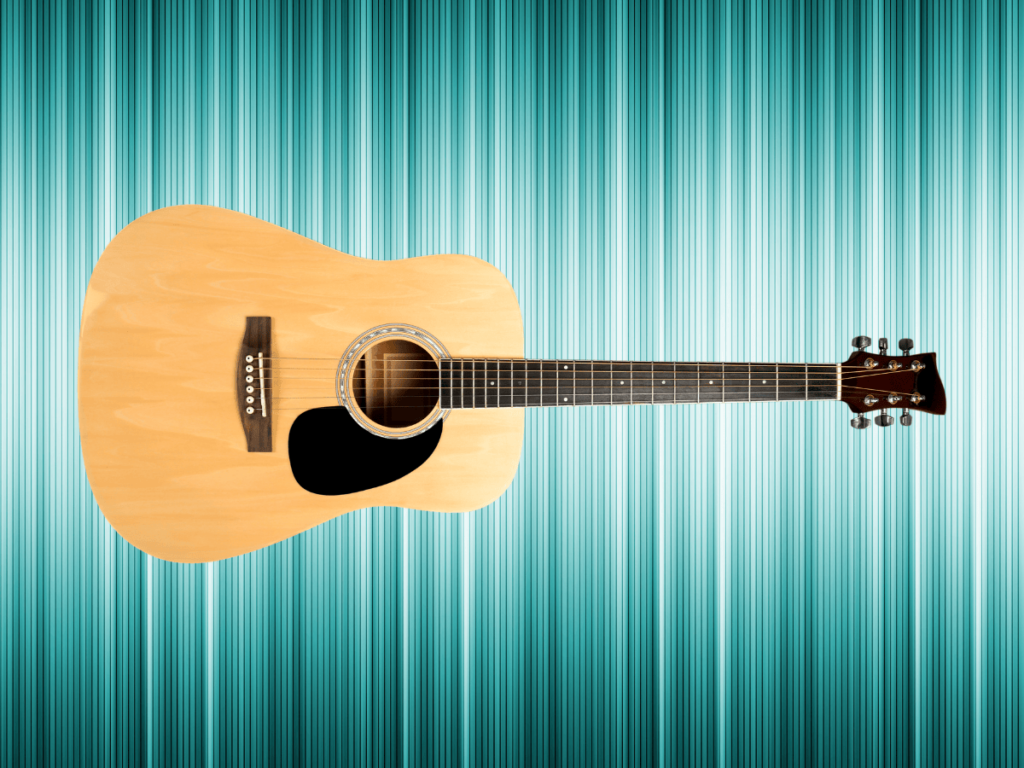
The traditional 6-string acoustic guitar
The traditional 6-string acoustic guitar is the most common type found in music stores and used by musicians worldwide.
The six strings tuned to different pitches, start from the low E string and goes up to the high E string.
The strings are usually made of steel, although some acoustic guitars may have nylon strings, which are generally found in classical guitars.
The six strings of an acoustic guitar are tuned in a specific order, following a standard guitar tuning pattern.
The tuning pattern for the standard 6-string acoustic guitar is E-A-D-G-B-E, with the thickest string (low E string) tuned to the lowest pitch, and the thinnest string (high E string) tuned to the highest pitch.
Each string produces a unique sound when plucked or strummed, allowing guitar players to create various chord progressions, melodies, and harmonies.
The six-string configuration provides various musical possibilities and versatility, making it a popular choice among guitar enthusiasts.
Alternative String Configurations
More strings:
For those seeking a broader sonic range or attempting more complex fingerpicking patterns, guitars with additional strings may be appealing. Some common variations include:
Seven-string guitars
Twelve-string guitars
Fewer strings
On the other hand, if simplicity is your preference or you’re looking for a different playing experience, guitars with fewer strings are available. Some options include:
Four-string guitars
Three-string guitars
Pros and Cons of Different String Configurations
Six-String Acoustic Guitars

Advantages: The six-string acoustic guitar is the most common and versatile option. It offers a wide range of tones and is suitable for various genres, from folk to rock.
Disadvantages: One potential drawback of the six-string acoustic is that it can be challenging for beginners to learn and master, as it requires more complex finger positioning.
Seven-String Acoustic Guitars

Advantages: The seven-string acoustic guitar adds an extra low string, typically tuned to B. This enhances bass notes and opens up new possibilities for chord voicings and melodies.
Disadvantages: The main drawback of the seven-string configuration is that it requires additional finger strength and dexterity to navigate the wider fretboard. It may also take some adjustment for players accustomed to six or five-string guitars.
Twelve-String Acoustic Guitars
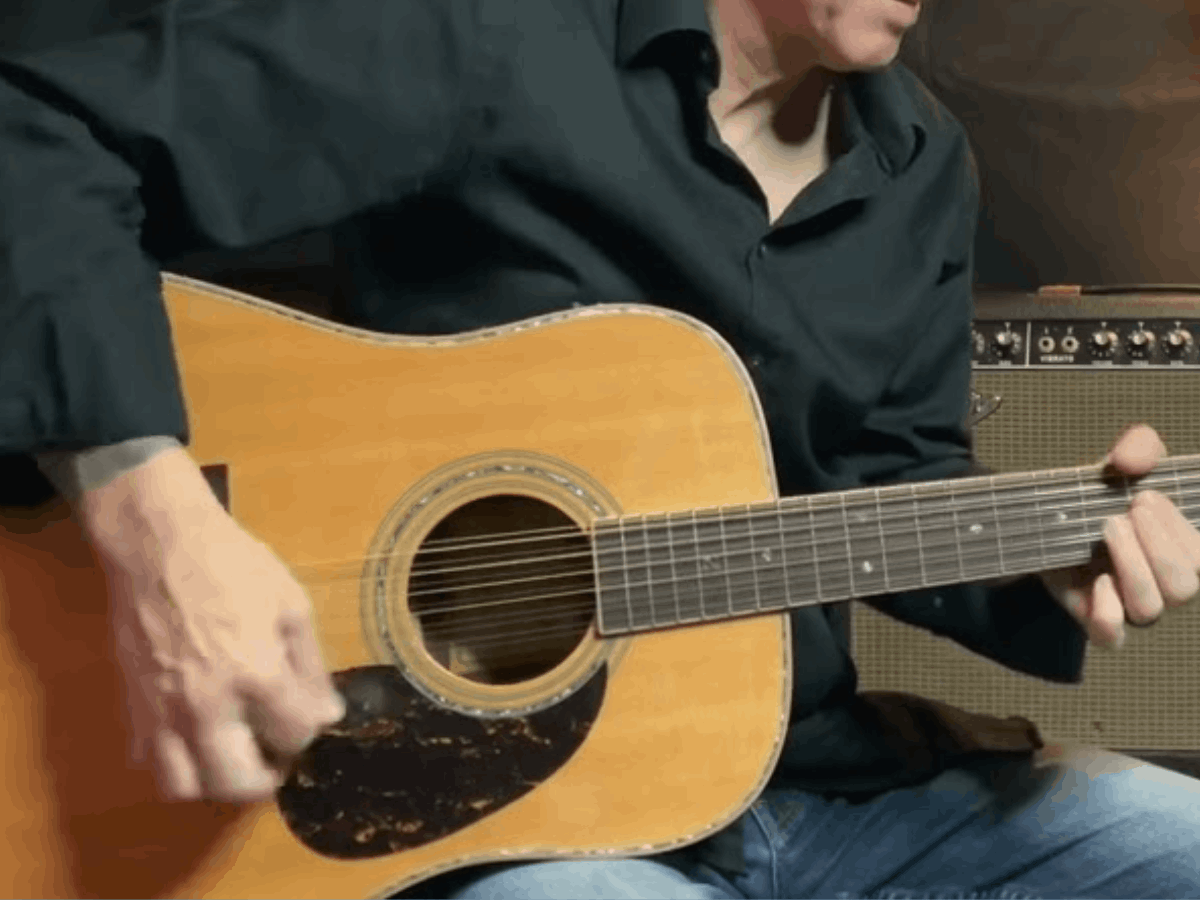
Advantages: The twelve-string acoustic guitar offers a fuller, richer sound with double courses of strings. It creates a unique shimmering effect and is commonly used in folk, country, and blues music.
Disadvantages: One challenge of the twelve-string acoustic guitar is the greater tension on the neck and strings, which can require more frequent tuning and maintenance. It can also be more physically demanding to play due to the extra strings.
Choosing the Right Guitar for You

It doesn’t matter if you’re a monkey or a human (!), the number of strings on an acoustic guitar can significantly affect your playing style, sound, and versatility.
To help you make an informed choice, here are some crucial factors to consider:
Musical Genre
Playing Style
Sound and Volume
Comfort and Playability
Price and Availability
Our Picks of the Best Acoustic Guitar Strings

DESIGNED FOR: All acoustic guitar players
FEATURES: Durable phosphor bronze coated string, that keeps their well-balanced and warm tone for a long time
OTHER INFO: String Gauges: Medium - 0.13 to 0.56
D'Addario EJ17-3D Phosphor Bronze, Medium, 13-56 x 3 Pack
When you check the price above, you’ll see there are loads of great places to buy this item. Our personal favorite is Gear4music.
It is the largest music retailer in the UK and fast becoming the most respected online music shop in the US too. Their customer service is excellent, they have competitive prices, really fast shipping, and usually have the longest guarantee.
Most professional musicians use Gear4music, so there is no reason why you shouldn’t too!
- Durable medium strings
- Corrosion-free
- High-quality strings
- The strings have a longer length, and you need to cut them after assembling
The professional musician who wrote this article combined many things,
from the product build, manufacturer’s reputation through to feedback
from other users, to create our famous TedScore™.
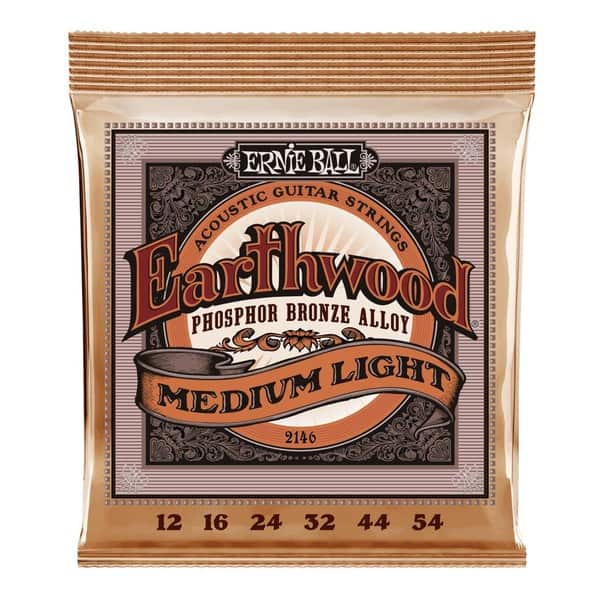
BEST OPTION FOR: Guitarists who like to solo on acoustic guitar
STRING GAUGES: Medium-light - 0.12-0.54
FEATURES: The strings are premium quality and tune together nicely with the bass and treble frequencies
Ernie Ball Earthwood Phosphor Bronze Medium Light 12-54
When you check the price above, you’ll see there are loads of great places to buy this item. Our personal favorite is Gear4music.
It is the largest music retailer in the UK and fast becoming the most respected online music shop in the US too. Their customer service is excellent, they have competitive prices, really fast shipping, and usually have the longest guarantee.
Most professional musicians use Gear4music, so there is no reason why you shouldn’t too!
- Rich, warm, and clear tone
- Great for solo performances
- The guitar strings come in medium and light gauges
- The guitar strings can snap easily
The professional musician who wrote this article combined many things,
from the product build, manufacturer’s reputation through to feedback
from other users, to create our famous TedScore™.
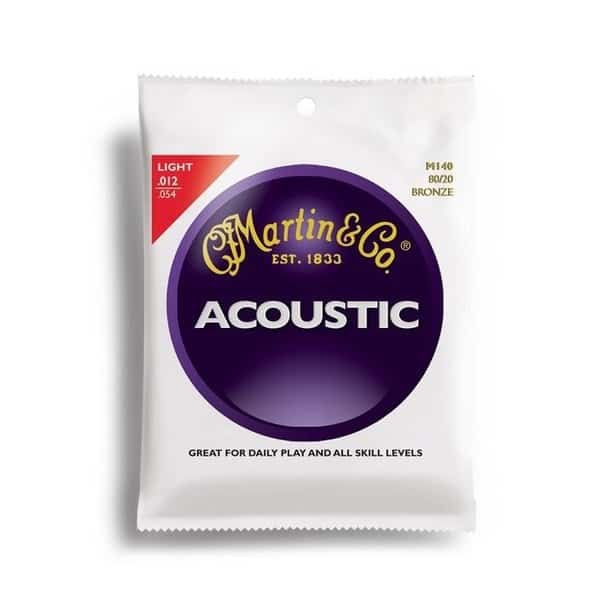
BEST OPTION FOR: Versatile players who enjoy playing more than one genre of music
STRING GAUGES: Light - 0.12-054
FEATURES: Light, cheap, and sound fantastic; 80 to 20 bronze ratio
Martin Original 80/20 Bronze Acoustic Strings Light, 12-54, 3 Pk
When you check the price above, you’ll see there are loads of great places to buy this item. Our personal favorite is Gear4music.
It is the largest music retailer in the UK and fast becoming the most respected online music shop in the US too. Their customer service is excellent, they have competitive prices, really fast shipping, and usually have the longest guarantee.
Most professional musicians use Gear4music, so there is no reason why you shouldn’t too!
- Affordable
- Suitable for any genre of music
- Bright sound
- The core is not 100% steel
The professional musician who wrote this article combined many things,
from the product build, manufacturer’s reputation through to feedback
from other users, to create our famous TedScore™.
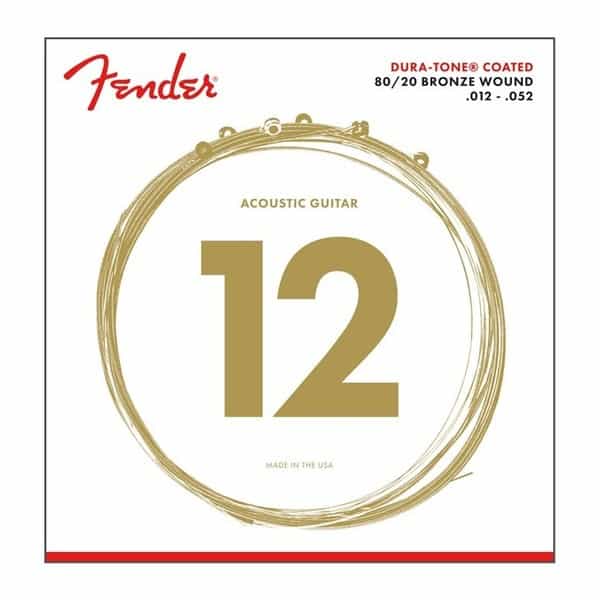
BEST OPTION FOR: Beginners and intermediate guitar players
STRING GAUGES: Light - 0.12-0.54
FEATURES: Top-notch quality; unique tone suitable for any music genre; five times longer lifespan than average guitar strings
Fender 880L 80/20 Dura-Tone Coated Acoustic Strings, 12-52
When you check the price above, you’ll see there are loads of great places to buy this item. Our personal favorite is Gear4music.
It is the largest music retailer in the UK and fast becoming the most respected online music shop in the US too. Their customer service is excellent, they have competitive prices, really fast shipping, and usually have the longest guarantee.
Most professional musicians use Gear4music, so there is no reason why you shouldn’t too!
- Long lifespan
- Mesmerizing acoustic tone
- Tuning stability
- The strings are in a “higher range” of the tone spectrum
The professional musician who wrote this article combined many things,
from the product build, manufacturer’s reputation through to feedback
from other users, to create our famous TedScore™.

BEST OPTION FOR: All styles of acoustic guitar players
STRING GAUGES: Medium - 0.13-0.56
FEATURES: Nanoweb-coated strings - clear treble sounds and last for a long time; phosphor bronze material
Elixir 11102 NANOWEB Medium Acoustic Strings, 13-56
When you check the price above, you’ll see there are loads of great places to buy this item. Our personal favorite is Gear4music.
It is the largest music retailer in the UK and fast becoming the most respected online music shop in the US too. Their customer service is excellent, they have competitive prices, really fast shipping, and usually have the longest guarantee.
Most professional musicians use Gear4music, so there is no reason why you shouldn’t too!
- A warm and vibrant tone
- Corrosion resistant
- Long-lasting
- A bit pricey
The professional musician who wrote this article combined many things,
from the product build, manufacturer’s reputation through to feedback
from other users, to create our famous TedScore™.
how many strings
does an acoustic guitar have?
Our Summary
Acoustic guitars are awesome because you can choose how many strings you want!
The standard tuning is six strings, but you can also get guitars with seven, eight, or even twelve strings for more options.
Go for a seven-string guitar if you’re into metal or progressive rock. If you’re feeling experimental, try an eight string guitar.
And if you want a rich, full-bodied sound, a twelve-string guitar might be just what you need.
Whatever you choose, the acoustic guitar is versatile and can deliver beautiful melodies and evoke all kinds of emotions.
Wait, there’s more!!!
Looking to strum your way to music stardom? Discover the 18 Best Acoustic Guitar Under 500 – the perfect harmony of quality and affordability, guaranteed to make your melodies soar!
FAQ's
No, not all acoustic guitars have 6 strings. Some acoustic guitars have 12 strings, while others may have 7 or 8 strings.
A classical guitar typically has six nylon or gut strings. However some classical guitars have seven or eight strings, but these are less common.
No, not all 12-string guitars are acoustic. There are also electric guitars with 12 strings used in various genres, such as rock and folk music.
Modern guitar strings are typically made of metal wire wrapped around a core wire. The wire is often coated with a thin material layer to protect against corrosion and improve durability.
While it’s possible to put acoustic strings on electric guitars, it’s not recommended. Acoustic strings are designed to produce a certain type of sound, and using them on an electric guitar can result in poor tone quality and potential damage to the guitar’s pickups.











i always thought all guitars were the same, this whole article’s been an eye opener. thx Lewis Turner
thanks LaraB!
Devon, it’s great that you’re expanding your knowledge! Guitars are indeed fascinating instruments.
Heh, I’ve got a 6-string, a 12-string, but where’s the love for my one-string wonder? It’s got one string, one fret, and a whole lot of attitude. Just kidding, man. Loved the article, really dug into the details without getting lost.
Lewis Turner, your article outlines a comprehensive overview of acoustic guitars. I found your section on standard acoustic guitars particularly enlightening. Regarding alternative string configurations, your insights could help many appreciate the versatility and range of acoustic guitars. It’s intriguing to consider how these different configurations can influence musical genres and playing styles. Your approach in dissecting the anatomy of an acoustic guitar lays a solid foundation for beginners while still engaging for intermediate players.
Hey, in the part where it talks about choosing the right guitar, how can I tell if a guitar’s sound and volume are good for me without trying it in person?
TerryG, a good tip is to watch videos of people playing the guitar model you’re interested in. It’s not the same as in-person testing, but it’ll give you a decent idea!